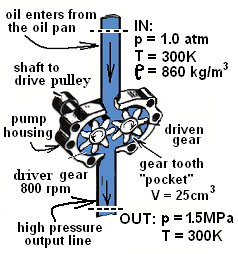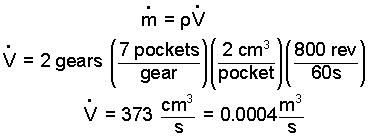| THERMO Spoken Here! ~ J. Pohl © | TOC NEXT ~ 240 |
Gear Pump

The gear pump of a running engine receives oil at atmospheric pressure from the oil pan. Power from the engine passes through a belt-driven pulley to the shaft of the pump's "driver gear." As the driver gear rotates, it forces the "driven gear" to rotate. Supply oil fills the spaces or "pockets" between the teeth of both gears. As the gears turn these "pockets" of oil are forced around the outer perimeter of the pump housing to exit at high pressure. Use the information of the figure.
Estimate the ideal, steady mass rate of the pump?
♦ At any instant, the amount of oil entering and leaving is the same. And also oil is incompressible hence mass cannot accumulate within the rigid boundary of the pump housing. The mass equation will tell us simply "what mass enters leaves."
The pump action is essentially a series of "volumes" or "pockets" of oil that are moved from the low-pressure to the high-pressure side of the gears with each revolution of the gears. From the drawing we see each gear has seven pockets each of volume three cubic centimeters. The two gears rotate as 800 rpm, so:
 |
(1) 1 |
What least, ideal, steady power does the pump consume?
♦ The energy equation will have some terms that are zero. We write the general form of the equation, then strike the inapplicable terms.
 |
(2) 2 |
The terms prefaced "d/dt" (left of equality) are zero because the pump is operating steadily. The entering and leaving kinetic and potential energies of the flowing oil are equal (or nearly equal). A step that is taken with incompressible "pumping" situations is to represent enthalpy, h, as u + p/ρ. With these changes and a little regrouping we have:
 |
(3) 3 |
The task of this pump is to receive power delivered to the shaft of the drive gear and (at constant flow of oil) convert all of that power to the increase of pressure the flow. The pump works optimally when design engineers get the "other three terms" to sum to zero. The other three terms, in an equation of their own are:
 |
(4) 4 |
Internal energy of a liquid is a function its temperature and specific volume: u = u (T , v). It is assumed that vout equals vin. Also the temperature increase with compression is small. Resulting is uin - uout ~ 0. We assume frictionless operation. Temperatures will remain what they were initially and the sum of heats will equal zero.
With the adjustments, the energy equation (for ideal operation) is:
 |
(5) 5 |
We express the pressure difference, pin - pout, as - Δp.
 |
(6) 6 |
Inspecting our result, we expect both W-dotshaft and [pout - pin] to be positive. So the signs of Eqn 6 are consistent. Below we check the terms for dimensional consistency.
 |
(7) 7 |
Now apply the numbers to obtain the pump power requirement.
 |
(8)8 |
We included the shaft of the drive gear as system to focus our equation. The task of that shaft is simply to convey work (from its belt drive to its gear and) to the oil. Were that shaft's bearings frozen or were gear teeth pitted and scared from trash that passed through, power to that shaft would arrive to the oil partly as work to pump and the rest as friction - to do nothing but stir things into a mess. The work rate of friction is assigned a negative sign in conformity with our sign conventions for work and heat. The negative sign means friction manifests itself in its system as a rate of energy loss. It is not that the system loses energy. It is that the system loses the ability to do work. Friction turns mechanical energy into thermal energy. The energy is still there, in thermal form. To make use of that thermal energy requires that it be put through a thermal engine. Phew! More tools and methods are needed to extend thermodynamics to solutions of frictional effects of the energy.

Gear Pump
The gear pump of a running engine receives oil at atmospheric pressure from the oil pan. Power passes from the engine through a belt-driven pulley to the shaft of the "driver gear." As the driver gear rotates, it forces the "driven gear" to rotate. Supply oil fills the spaces or "pockets" between the gear teeth of both gears. As the gears turn these "pockets" of oil are forced around the outer perimeter of the pump housing to exit at high pressure.
What ideal, steady mass rate of oil does the pump deliver?
Premise presently unwritted!